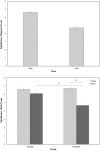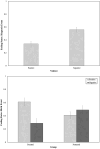Mothers' reflections on the diagnosis and birth of their child with Down syndrome: Variability based on the timing of the diagnosis
- PMID: 38989812
- PMCID: PMC11907182
- DOI: 10.1002/jgc4.1946
Mothers' reflections on the diagnosis and birth of their child with Down syndrome: Variability based on the timing of the diagnosis
Abstract
Previous research has examined parents' reflections on their child's Down syndrome diagnosis based on whether the diagnosis was provided prenatally or after birth, revealing few significant differences; by comparison, few studies have examined parents' reflections on the birth of the child in relation to the timing of the diagnosis. This study was conducted to examine whether mothers differentially reported on and rated the diagnosis, birth, and most recent birthday of their child with DS based on when the diagnosis was provided. Forty-four American mothers of children with DS discussed the birth of their child, when they learned of their child's DS diagnosis, and their child's most recent birthday with a researcher. Participants also completed online questionnaires on which they rated the events and indicated how they felt about the events at the time of their occurrence and at the time of the study. The results revealed that participants who received a prenatal diagnosis of DS for their child reflected differently-and seemingly more positively-on their child's birth relative to participants who received a postnatal diagnosis. These differences were evident when considering participant ratings, emotion language used when discussing the events, and feeling states characterizing how participants felt about the events at the time of their occurrence and at the time of the study. Given these group differences, medical professionals should carefully consider the conditions under which they provide mothers with diagnostic information and support services after a child is born.
Keywords: disability; family; genetic counseling; genetic testing; parents; prenatal diagnosis.
© 2024 The Author(s). Journal of Genetic Counseling published by Wiley Periodicals LLC on behalf of National Society of Genetic Counselors.
Conflict of interest statement
AFL and JGB declare that they have no conflicts of interest.
Figures





Similar articles
-
"What does this mean for our future?" uncertainty management in mothers' narratives about the diagnosis and birth of their child with Down syndrome.PLoS One. 2024 Nov 6;19(11):e0313195. doi: 10.1371/journal.pone.0313195. eCollection 2024. PLoS One. 2024. PMID: 39504324 Free PMC article.
-
Receiving the news of Down syndrome in the era of prenatal testing.Am J Med Genet A. 2020 Feb;182(2):374-385. doi: 10.1002/ajmg.a.61438. Epub 2019 Dec 21. Am J Med Genet A. 2020. PMID: 31863634
-
KAP study on mothers of children with Down syndrome.Indian Pediatr. 1991 Sep;28(9):997-1001. Indian Pediatr. 1991. PMID: 1839390
-
Postnatal diagnosis of Down syndrome: synthesis of the evidence on how best to deliver the news.Pediatrics. 2009 Oct;124(4):e751-8. doi: 10.1542/peds.2009-0480. Epub 2009 Sep 28. Pediatrics. 2009. PMID: 19786436 Review.
-
Parents' and health professionals' perceptions concerning parental stress during a child's hospitalization.Child Health Care. 1990 Winter;19(1):37-42. doi: 10.1207/s15326888chc1901_5. Child Health Care. 1990. PMID: 10106397 Review.
Cited by
-
"What does this mean for our future?" uncertainty management in mothers' narratives about the diagnosis and birth of their child with Down syndrome.PLoS One. 2024 Nov 6;19(11):e0313195. doi: 10.1371/journal.pone.0313195. eCollection 2024. PLoS One. 2024. PMID: 39504324 Free PMC article.
References
-
- Abbeduto, L. , Seltzer, M. M. , & Shattuck, P. (2004). Psychological well‐being and coping in mothers of youths with autism, down syndrome, or fragile X syndrome. American Journal on Mental Retardation, 109(3), 237–254. - PubMed
-
- Akolekar, R. , Beta, J. , Picciarelli, G. , Ogilvie, C. , & D'Antonio, F. (2015). Procedure‐related risk of miscarriage following amniocentesis and chorionic villus sampling: A systematic review and meta‐analysis. Ultrasound in Obstetrics and Gynecology, 45(1), 16–26. 10.1002/uog.14636 - DOI - PubMed
-
- American College of Obstetricians and Gynecologists . (2024). Prenatal genetic diagnostic tests . https://www.acog.org/womens‐health/faqs/prenatal‐genetic‐diagnostic‐tests
-
- Bahrick, L. E. , Parker, J. F. , Fivush, R. , & Levitt, M. J. (1998). The effects of stress on young children's memory for a natural disaster. Journal of Experimental Psychology Applied, 4(4), 308–331. 10.1037/1076-898X.4.4.308 - DOI
-
- Caughey, A. B. , Kuppermann, M. , Norton, M. E. , & Washington, A. E. (2002). Nuchal translucency and first trimester biochemical markers for down syndrome screening: A cost‐effectiveness analysis. American Journal of Obstetrics and Gynecology, 187(5), 1239–1245. 10.1067/mob.2002.127144 - DOI - PubMed

